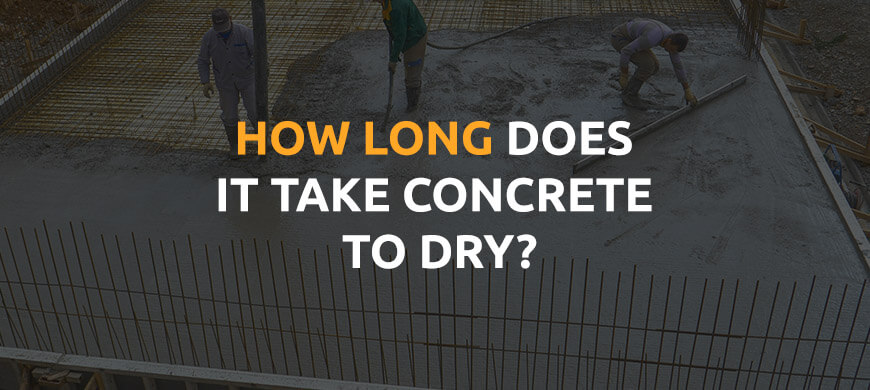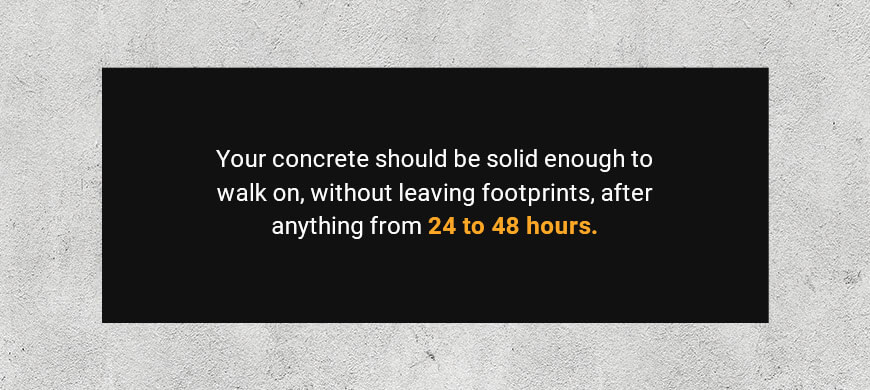
How Long Does Concrete Take to Dry?
Posted By:Dynamic Concrete Pumping , Date: Apr 22, 2019

Concrete typically takes 24 to 48 hours to dry enough for you to walk or drive on it. However, concrete drying is a continuous and fluid event, and usually reaches its full effective strength after about 28 days.
Here are some of the basic facts regarding the question of concrete drying and curing time.
What Is Curing?
Although you might be able to see the visual effects of curing on the concrete’s surface, changes also happen at various depths, down through the concrete’s core. The end result is the hard, resistant surface we rely on for driveways, sidewalks, foundations and other surfaces. Curing is not the same thing as drying. While curing gives concrete its physical properties, drying takes place during and after the curing process to help the concrete reach the specific conditions required for its intended application.
There are multiple curing methods for concrete, but water curing and membrane curing are some of the most common:
- Water curing: Uses water pouring, sprinklers, ponding or immersion to maintain continuous moisture levels in the concrete.
- Membrane curing: Liquid membrane is applied to the concrete where it solidifies into a water-based or oil-based membrane layer to eliminate evaporation.
Other curing methods include left-in-place forms and covering concrete with special blankets or sheets.
What Makes Concrete Harden?
Changes happen inside the concrete mixture both during and after the curing process. When cement is mixed with water, rock-like crystals begin growing, giving the soon-to-be concrete its strength. The concrete’s moisture levels and temperature must stay in the right range — the wrong amount of water causes cracks or shrinking and prevents crystal growth. When the concrete gets too cold, the crystal reaction process stops entirely.
Specific hardness levels vary depending on the concrete mixture’s specific ingredients and proportions. Some concrete pourers rely on strength and hardening accelerant methods like steam, heating coils or heated forms. Never attempt this on your own, as it’s not suitable for every application, and incorrect acceleration can leave you with damaged concrete and wasted materials.
Concrete starts hardening as soon as it’s poured, but it’s far from ready. Give it at least 24 hours of concrete cure time before allowing any light foot traffic and even longer before putting any significant weight on the surface.
How Long Does It Take Concrete to Cure Completely?
The answer is that concrete never cures completely. It is always hardening a little bit more each day. The way concrete hardens is a function of the cement particles reacting with the water it is mixed with. As the cement bonds with the water molecules, the concrete gets harder. There are always tiny moisture bubbles in your concrete, so even after achieving what is commonly thought of as “full strength,” your concrete will keep getting slightly harder.
The real question is how long does concrete take to set enough for whatever your purposes are for the concrete. For example, how long before you can walk on it without leaving footprints, drive or park on it without sinking into it, etc.
The answer is that your concrete will be ready in a surprisingly short time. Your concrete should be solid enough to walk on, without leaving footprints, after anything from 24 to 48 hours. By seven days, your concrete should be cured to at least 70 percent of its full strength. You will probably be able to drive on it without damaging it, although you may want to hold off on rolling heavy equipment over it. In 28 days, you can treat your concrete as fully hardened.
contact us for concrete pouring services
What Are Some of the Factors That Affect How Long Concrete Takes to Dry?
How long does concrete take to dry under different conditions? Concrete drying times are not necessarily consistent across situations. How long you should let concrete cure depends on several factors that can affect drying time. Some of these include:
Moisture
Water facilitates the curing and hardening processes. Without it, the chemical reactions needed to form the hard crystals that give the concrete its strength can’t take place. Too little water leads to structurally weak concrete, and too much will disrupt effective curing and cause flaking, shrinking, divots or cracks.
Avoid pouring concrete if rain or storms are likely — puddling and water channels can wear down un-cured concrete, creating imbalanced moisture levels and causing irreversible damage. If your concrete has had at least six to eight hours to cure before a quick rainshower, it should be OK — but younger mixtures or heavier, prolonged rains could cause trouble as it absorbs the excess water.
Don’t apply anything to your concrete while it’s still curing — paints and stains can also interfere with moisture content and chemical processes.
Temperature
Hot and ambient temperatures are usually ideal for concrete curing, as it helps moisture evaporate faster. That said, excessively high temperatures aren’t safe to work in, especially if you’re pouring large areas of concrete at a time. Too much humidity may also disrupt moisture and make temperature control difficult.
Cold temperatures are less forgiving for concrete curing — when temperatures are below 4 degrees Celsius or 40 degrees Fahrenheit, special concrete pouring techniques are required. Below -6 degrees Celsius or 20 degrees Fahrenheit, it’s best not to pour concrete.
While planning your concrete projects around the warmer seasons and temperatures is ideal, cold spells aren’t always predictable. If you’re working in the spring or fall where dips in temperature are common, consider investing in insulation for un-cured concrete and keep it safely sealed from cold temperatures for at least a few days, if not longer.
Mix Design
Some concrete mixtures cure faster than others. These “quick-drying” formulas require specific techniques to mix and pour correctly, and they don’t guarantee the same concrete strength and stability as traditional concrete formulas.
The same is also true of adding accelerants to concrete mixtures before curing — it may work for some small applications, but don’t expect your final result to have the same durability.
Leave Your Commercial Concrete Projects to Us
The curing time for concrete depends on several different factors, and even small missteps could force you to redo your project. Save yourself the hassle and materials, and give the team at Dynamic Concrete Pumping a call. We’ve got over four decades of industry experience and are equipped to take on commercial projects of all sizes and applications.
Request your free quote today!
-Updated 10/7/2022



